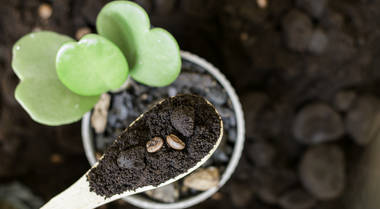Guide to Composting With Used Coffee Grinds
June 23, 2023
by Eric Thompson

This beginners guide will be far from exhaustive and will provide an intro to the idea of composting your used coffee grounds. It may take some effort to incorporate coffee grounds well, but it keeps your geisha honey out of landfills while nourishing your garden. Here we'll provide a brief intro to get your feet on the path.
Types of Composting for Coffee
Due to coffee's phytotoxicity, coffee grounds need to be used and composted rather than sprinkled directly over plants. Coffee not handled properly can stunt plant growth.Coffee is high in Nitrogen, containing about 2% by volume. You must be cautious to maintain the correct carbon-to-nitrogen ratio. Look for a ratio of 30 parts carbon to 1 part nitrogen in your compost chemistry. Carbon provides energy for microbes that break down organic matter into compost. Green and brown materials, which are nitrogen- and carbon-rich respectively, must be carefully balanced.
WeâÂÂll start with a handful of composting styles.
Vermicomposting
Composting with worms should be avoided with coffee as much as possible, though it can still be done. Spent coffee ground composting can lead to high earthworm mortality, though it can be greatly reduced by incorporating over 40% of used paper coffee filters and cardboard as a carbon source. Be sure to mix your used grounds with other nitrogen-rich materials to dilute the mixture.Despite the mortality caused by grounds, earthwoms love the nitrogen that is produced.
Composting in place
Despite phytotoxicity that can come from un-composted coffee grounds, a method that is available, but not recommended most, is composting in place. Composting in place is a layering method, oftentimes called âÂÂlasagna beds,â in the garden. This method alternates adding separate layers of nitrogen- and carbon-rich materials, resembling a lasagna in its construction. Ripped up paper coffee filters can act as a good carbon source.Be sure that coffee grounds are well mixed with other organic materials to avoid a water resistant layer.
Hot and cold composting
Hot composting uses heat to help microbes break down compostable materials quickly, decomposing in two to four weeks. Be sure coffee grounds are mixed with other nitrogen-rich materials, such as green grass clippings and food scraps.It is a more active process than other methods.
To meet compost needs, it is important to ensure the pile remains between 135ðF and 160ðF. Make sure the pile is moist (without being too wet) and stir it once per week to ensure aeration.
Cold composting with coffee grounds is a slower process that doesn't require active monitoring. This process allows for the decomposition of organic matter to take place over six months to a year. The decomposition of coffee grounds in a cold composting environment will produce a more nutrient-rich soil over time.
Both of these methods reduce the probability of earthworm mortality and stunted plant growth.
3 More Uses of Coffee in the Garden
We have hit on the types of composting that you can do with coffee, but it has some extra uses around the garden. If you have hit capacity on your compost, consider:1. Raising your soil acidity for flowers like azaleas by mixing in unused coffee. Again, be careful of phytotoxicity in surrounding plants
2. Craft a coffee âÂÂteaâ for a liquid fertilizer by re-steeping your used grounds overnight in tepid water. Look for a ratio of 2 cups of used coffee to 5 gallons of water
3. Mix in with the soil of tolerant plants to act as a slug and snail repellant. Though caffeine solutions work better, this is a home remedy that uses your grounds
